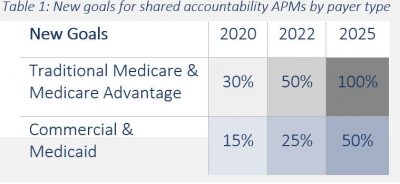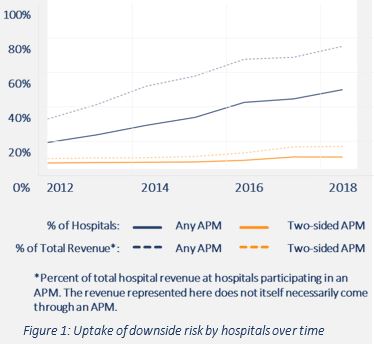Ambitious Goals for the Future of Value
The Health Care Payment Learning & Action Network (HCP-LAN or LAN) recently released aggressive new goals for moving the broader market from fee-for-service (FFS) to value-based payment (VBP).

The new goals aim to shift all Medicare payments and half of Medicaid and commercial health care payments into downside-risk models (LAN Categories 3B and 4) by 2025 (Table 1). In 2018, the LAN found that only 14.5 percent of all health care payments were tied to downside risk, up from 12.5 percent in 2017 but still below the 2020 goal, especially for commercial and Medicaid payments (Figure 1).
Although there is an increase in Alternative Payment Models (APM) adoption across payer types, the market is not adopting downside risk at the rate required to achieve the LAN’s targets. Leavitt Partners sought to better understand APM adoption by provider type, focusing on hospital participation in downside risk.

Leavitt Partners’ Analysis
Using the LAN’s APM adoption data supplemented by contract-level data from Torch Insight, Leavitt Partners examined APM adoption among hospitals. Researchers analyzed hospital engagement in APMs over time and profiled hospital adopters at different stages of the value movement.
Leavitt Partners’ Findings
Leavitt Partners found that currently only 7 percent of hospitals are participating in two-sided APMs (Categories 3B and 4), and these hospitals likely have well below 100 percent of their revenue in these contracts. If hospitals that have already entered two-sided APMs did move all of their revenue to risk-bearing contracts, it would at best, represent only about 14 percent of hospital revenue under risk (Figure 1). In order for the LAN goals to be achieved, many more entities will need to enter two-sided arrangements.
The full brief is available to Leavitt Partners’ Health Intelligence Partners (HIP) members. To learn more about HIP, please email [email protected].